Official Name:
Brenham takes its name from the village where the first fragments were found. It is also sometimes called Kiowa County or Haviland.
Location:
On farmland outside Brenham, Kiowa Co., Kansas, USA.
Fall or Find:
Find
Date:
The first fragments of Brenham were probably found in 1886 by a cowboy. Unable to transport the fascinating stones, he left them where they were.
Mass Recovered:
3 metric tons of the Brenham meteorite have been recovered.
Number of Fragments:
There are thousands of fragments from this shower. Their masses vary from a few grams to 630 kilograms.
Strewn field:
The strewn field of the fragments found covers several farms.
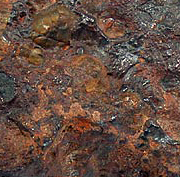
Enlargement
277-gram fragment of the Brenham pallasite. The long time spent in the ground greatly altered its surface. |
|
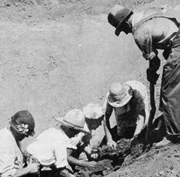
Enlargement
Search undertaken by H.H. Nininger in the Haviland crater. Most of the diggers were members of the Kimberly family or neighbouring families. |
|
Crater:
In 1929, Nininger identified an impact structure associated with this meteorite: the Haviland crater. This is an 11 by 16.75 metre oval depression, about 3.35 metres deep. The sides of the crater rise above the ploughed field. Today, the crater is practically impossible to detect. It has been completely levelled to make farming easier.
Circumstances:
Frank and Eliza Kimberly became homesteaders outside Brenham at the end of the 1880s. As they ploughed, they sometimes hit heavy black rocks that they removed from their fields. The rocks intrigued Eliza. Composed of iron and yellow crystals, they reminded her of an enormous meteorite that she had seen as a schoolgirl. So Eliza collected the rocks. She rapidly accumulated over a ton of the material. She convinced a geologist to examine her finds. The specialist agreed with Eliza-they really were fragments of a stony-iron meteorite-and he bought some of them. The sum they received allowed the Kimberlys to buy the land next to theirs. This land also contained pallasites, which Eliza and Frank rushed to collect.
A few years later, several small, oxidized masses were found in the soil. In 1947, several hundred kilograms of fragments were recovered. They were buried less than 1.5 metres deep. Today, the new landowners still find oxidized fragments now and then when they dig. In October 2005, the meteorite hunter Steve Arnold obtained the permission from the landowners to carry out excavations. Using a powerful metal detector and a backhoe, he discovered a 630-kilogram oriented fragment! It is the Brenham meteorite's new main mass and the most massive pallasite fragment ever found in the United States.
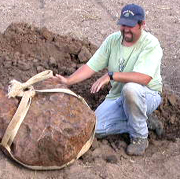
Enlargement
Meteorite hunter Steve Arnold with the new 630 kilograms Brenham main mass. |
|
History:
Fragments of the Brenham meteorite have been found as far away as 1 500 kilometres from the village. They were transported by groups of Native Americans and placed in the Hopewell burial mounds (in present-day Ohio) over 1 500 years ago. A few fragments were also hammered to make knives and various ornaments.
Type:
Stony-iron meteorite
Group:
Pallasite
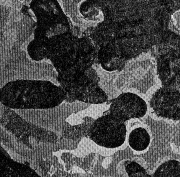
Enlargement
This slice of Brenham shows its particular composition. On the left is pure iron-nickel, while on the right, olivine crystals are dominant. |
|
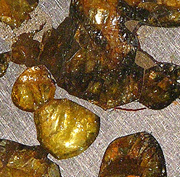
Enlargement
This slice of the Brenham meteorite has been altered by lawrencite: cavities have formed around certain grains of olivine. These grains will eventually fall out. |
|
Composition:
The interior of the Brenham pallasite varies in composition. Some parts are made up of pure iron-nickel, while in other parts olivine occupies twice the volume as the metal. The olivine crystals are very fractured. The metallic sections have the characteristics of an iron meteorite: when they are etched with acid, Widmanstätten figures appear.
Brenham is one of the pallasites the most affected by lawrencite, a mineral that causes the iron-nickel network to slowly disintegrate. As a result, the olivine crystals fall out and then the meteorite fractures.
Scientific contribution:
While studying the Haviland crater, Nininger realized that two main types of craters exist. Those formed by massive objects hitting the ground at high speed are always round, because there is an explosion at the time of impact. Smaller masses do not have enough energy to create such a powerful shock wave, so oval craters are created by the meteorite as it ploughs into the ground.
Comments:
Haviland is one of the rare American craters where debris from meteorites has been found.
Part of the Planétarium's collection:
Yes